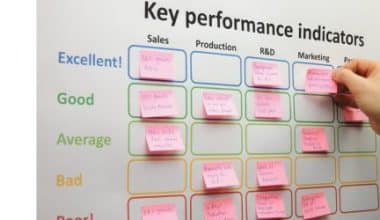High turnover rates could lead to a significant loss in output and revenue. Businesses spend money and time training new hires and enhancing their skills after they are hired. Programs for employee retention can assist you in safeguarding your most priceless resource: your workforce. High employee turnover costs you time and money and shows that your company is more of a stepping stone than a final destination. The federal government makes a conscious effort to create employee retention programs. Because agencies spend a sizeable amount of money on hiring, training, and recruiting employees. There are several examples of good employee retention programs to implement. Read further to find out more
Employee Retention Program
Keeping your most valuable assets, your employees is the goal of an employee retention program. High employee turnover costs you money and time and may suggest that your company is more of a stepping stone than a final destination. Keep your best employees and increase productivity with a well-thought-out retention program. The procedures and plans a business develops to keep its best employees are referred to as employee retention programs. Additionally, the program aims to reduce the risks of turnover, which are a major challenge for HR teams globally.
How to Create an Employee Retention Program
#1. Encouraging Open Communication
You can encourage a culture where workers feel free to express their opinions. In other words, they require a place of employment where they can voice their opinions and issues without restriction. One of the best ways to build a culture of openness and trust is through an “open-door policy,” which is a form of communication. It demonstrates your openness to hearing their opinions at any time.
#2. Measure Your Turnover Rate
Understanding your position with industry benchmarks is the first step in creating or improving an employee retention program. Utilize the appropriate formulas and calculators to determine your employee turnover rate, compare it to the industry standard, and discuss the results. You can raise or keep your rates based on whether your turnover is high or low.
#3. Personal Development and Growth
Good employees are motivated to advance. Although perks and other benefits are good, they can not always be tailored to each employee’s preferences. The federal government executives can create employee retention program by finding out what drives their employees by asking them about their aspirations. Allow them to work with various teams and departments as well as suggest seminars and courses they might find interesting. Even training unrelated to their current position can be helpful because it distinguishes them from other employers and demonstrates that you genuinely care about your staff.
#4. Recognition
Some employers believe that honors like “Employee of the Month” mean a lot to their staff members, but this is not necessarily the case. Employees typically prefer to be acknowledged for their work right away rather than much later because if they wait, they may not feel valued. Everyone is aware that workers enjoy receiving praise from their managers. However, peer praise is also important and can be very powerful. When their peers acknowledge their efforts, workers feel appreciated.
#5. Good Relationship with Managers
Poor leaders lose talented workers. Managers should receive mentoring to develop strong bonds with their teams. The best way to avoid disagreements and misunderstandings at work is to communicate effectively. Even if you do not end up being best friends, listening intently will put your staff at ease. In the end, friendly relationships foster a welcoming environment.
#6. Working Environment
Federal government executives creating a good working environment is a good employee retention program Therefore, you must ensure that your workplace attracts, keeps, and supports great people. Free lunches, snacks, and gym memberships are excellent benefits that do not cost a lot of money. Work-life balance is now a key component of employee engagement. You may be able to retain your best employees by providing flexible work schedules, establishing a work-from-home policy, and promoting time off.
#7. Employee Compensation
Better prospects are among the main factors that cause employees to leave their jobs. Employers who want to keep their staff can start by paying them competitively. It would raise their spirits and encourage them to perform better. Include salary ranges in job descriptions as a good place to start. This would aid candidates in determining how well they fit a company.
Employee Retention Program Examples
#1. Create mentoring and training initiatives
Creating training opportunities is a good example of employee retention program that federal government executives can implement. An efficient way to train new employees is through mentoring, which also gives tenured employees the confidence to impart their expertise to a new hire. To make sure that new employees can learn quickly and have access to resources for studying, a mentoring program must be established. Additionally, it simplifies and lightens the mentor’s task. Therefore, it benefits everyone.
#2. Encourage a Healthy Work-Life Balance
At a certain point, overworked workers stop producing. They are more susceptible to stress-related illnesses when their bodies and minds are exhausted. When the work becomes too demanding and they run out of time for personal growth, they may eventually give up. Therefore, this is a good example of employee retention program to execute.
#3. Provide Flexible Schedules for Employees
Although it may not apply to all workplaces, businesses can be flexible with their work arrangements if doing so will help them retain their current workforce.
#4. Making Financial Wellness Programs Available
Federal government executives are in a good position to provide wellness programs to their workers. A financial wellness program is subjective. Every employee’s financial situation and desired outcomes should be taken into account when creating it. Employee wellness programs can increase productivity and increase workers’ job satisfaction, so they are used as a retention strategy for current employees as well as a recruiting strategy for new hires. The following are a few advantages for staff financial wellness to mention:
- Retirement plans
- Repaying student loans
- Flexible paydays
- Programs for tailored financial guidance
#5. Feedback and Action
Companies place a high value on their employees, so they must be free to express their opinions without fear of rejection or criticism from management or their coworkers. Employers who value their skilled workers listen to what they have to say, implement their suggestions when appropriate, and offer feedback when a suggestion is not practical for the business.
Federal Government Employee Retention Program
Federal government employers would be wise to hire experts to educate staff members on topics relating to their job. The federal government employee retention program is not all that different from employee retention at any other company or organization.
Employees can choose from a variety of plans, and the federal government contributes significantly to the cost of premiums. The employee is responsible for understanding the specifics of their plan, including coverage, deductibles, co-payments, and the maximum out-of-pocket costs. Contrary to the government, which allows employees to select from a wide range of plans, the private sector typically does not provide this choice.
Here are some of the best programs for employee retention of government workers while maintaining their drive to deliver their best work:
#1. Offering Supplemental Incentives
This entails offering employee retention incentives, such as justifiable pay raises, to entice staff to stick with the company over competing job opportunities. Retention incentives must be fully supplemental to an employee’s base pay, specifically tailored to meet needs, and not exceed incentives typically provided by the recipient or compensation provided by rival employers in a bid to recruit the employee.
#2. Adopt a Genuine Workplace Culture
It helps greatly if there is a sense of belonging among coworkers. However, a lack of work culture is a common criticism leveled at government organizations. Government leaders should promote social interaction among staff members, remind them of the significance of their work as public servants, and extol the virtue of enhancing communities and fostering positive experiences for all.
#3. Offer a Hybrid Work Schedule
As the pandemic changed workplace expectations, many Americans adapted to working from the convenience of their homes, while others yearned to go back to the office. The best of both worlds can be found in a hybrid government work culture, which is an alluring proposition. Employees can complete their work from any location at any time with the help of a centralized, cloud-based management platform.
#4. Provide Ongoing Training and Mentorship
People tend to follow leaders who are eager to assist them in their learning. Government leaders should actively try to assist staff members who require it. Your department ought to go a step further and regularly host training sessions that educate on important departmental topics. The most dedicated workers who are eager to learn will feel inspired to continue working for your office with the help of mentorship and educational training.
#5. Provide Constructive Criticism
Giving honest feedback is essential to being a successful mentor. Good workers want to do the best work they can, and your feedback will not only help them improve at their jobs but also make them more devoted to you and your company.
People Also Ask What Is the Employee Retention Program?
Management of employee retention entails taking calculated steps to keep staff members motivated and on task so they choose to stay on the job and contribute to the success of the company. A thorough employee retention program is essential for attracting and keeping key employees, as well as for lowering turnover and the costs associated with it.
Who Qualifies for the Employee Retention Credit?
You might be eligible for ERC if your company or organization saw a significant drop in gross receipts in either 2020 or the first three quarters of 2021. Employers may apply for the ERC if they suffered partial closures or sizable drops in quarterly gross receipts as a result of the COVID-19 pandemic.
Has Anyone Received ERC Refund 2023?
The time it takes for businesses to get their ERC refunds will vary. It might have taken up to six weeks to initially deliver your employee retention tax credit reward. However, due to a backlog of claims filed with the IRS, this has been extended by a few months. After filing their return, the majority of employers can anticipate receiving their ERTC refund six to twelve months later.
How to Get a $7,000 Tax Refund?
The Earned Income Tax Credit can be refunded, so any money that is left over is added to a tax refund once taxes have been subtracted. The best option if you want to receive your ERC refund faster is to work with an ERC advance provider. To do this, you will need the following documentation: IRS 941 forms for the years 2019, 2020, and 2021, as applicable signed IRS 941x forms for 2019 through 2021, along with IRS submission documentation
Who Is Not Eligible for Erc?
The ERC generally does not apply to wages paid to majority owners who own more than 50% of the business directly or indirectly. A business owner’s wages may, however, be eligible for the ERC in certain circumstances. If you did not run a company or a nonprofit organization that was tax-exempt and had employees, you are not eligible for the ERC. Others include:
- Employees
- Retirees
- Individuals without employees
- Domestic employers
- Employers who failed to pay employees during the applicable periods
- Employers who had supply chain disruptions but were not completely or partially shut down by a qualifying order
- Government agencies
Can I Still Apply for the Employee Retention Credit in 2023?
It is open to business owners who kept paying workers between March 13, 2020, and December 31, 2021, whether they were forced to close their doors because of the COVID-19 pandemic or saw a significant drop in revenue. By June 2023, companies can still submit ERC claims for 2020 and 2021. April 15, 2024, is the cutoff date for ERC claims for all of the 2020 quarters. By April 15, 2025, ERC claims for the entire year 2021 must be submitted.
Is It Too Late to File for the ERC Credit?
The deadline to submit an ERC application is April 15, 2024, for all 2020 quarters. To receive ERC credit for any quarter in 2021, applications must be submitted by April 15th, 2025. In 2023, 2024, and 2025, if you have not already, you can still apply for the employee retention credit.
Conclusion
Measuring turnover rates, putting fair compensation strategies into place, fostering a positive work environment, developing strong manager-employee relationships, encouraging personal development, recognizing accomplishments, and offering necessary support are all necessary to develop an effective employee retention program. Employee satisfaction and productivity can be greatly increased by developing strategies that are specific to your company’s requirements and culture. Companies can successfully address these issues and hold onto their best talent by implementing strong and effective employee retention programs and strategies.
Related Articles
- RETENTION STRATEGIES:15+ Proven strategies in 2023
- How to Apply for Employee Retention Credit (Complete Guide)






